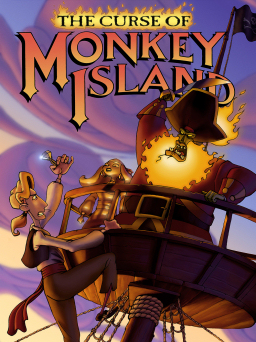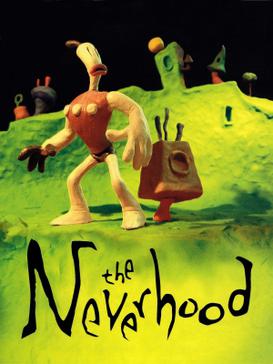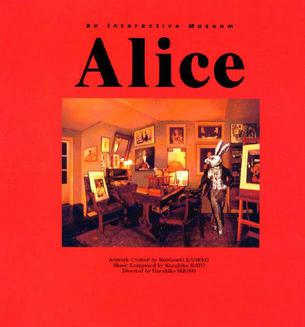Sierra Entertainment, Inc. was an American video game developer and publisher founded in 1979 by Ken and Roberta Williams. The company is known for pioneering the graphic adventure game genre, including the first such game, Mystery House. It is known for its graphical adventure game series King's Quest, Space Quest, Police Quest, Gabriel Knight, Leisure Suit Larry, and Quest for Glory, and as the original publisher of Valve's Half-Life series.

The Curse of Monkey Island is an adventure game developed and published by LucasArts in 1997. A sequel to 1991's Monkey Island 2: LeChuck's Revenge, it is the third game in the Monkey Island series.

The Neverhood is a 1996 point-and-click adventure video game developed by The Neverhood, Inc. and published by DreamWorks Interactive for Microsoft Windows. The game follows the adventure of a claymation character named Klaymen as he discovers his origins and his purpose in a world made entirely out of clay. When the game was originally released, it was unique in that all of its animation was done entirely in claymation, including all of the sets. The gameplay consists mostly of guiding the main character Klaymen around and solving puzzles to advance. Video sequences help advance the plot. In addition to being unique, The Neverhood aimed at being quirky and humorous, as is evident by the characters, the music, and the plot sequence. It received a sequel in 1998, Skullmonkeys, which was a platform game, abandoning the adventure format of the original.

Starship Titanic is an adventure game developed by The Digital Village and published by Simon & Schuster Interactive. It was released in April 1998 for Microsoft Windows and in March 1999 for Apple Macintosh. The game takes place on the eponymous starship, which the player is tasked with repairing by locating the missing parts of its control system. The gameplay involves solving puzzles and speaking with the bots inside the ship. The game features a text parser similar to those of text adventure games with which the player can talk with characters.

Steven Eric Meretzky is an American video game developer. He is best known for creating Infocom games in the early 1980s, including collaborating with author Douglas Adams on the interactive fiction version of The Hitchhiker's Guide to the Galaxy, one of the first games to be certified "platinum" by the Software Publishers Association. Later, he created the Spellcasting trilogy, the flagship adventure series of Legend Entertainment. He has been involved in almost every aspect of game development, from design to production to quality assurance and box design.
The Learning Company (TLC) was an educational software company founded in 1980 in Palo Alto, California and headquartered in Fremont, California. The company produced a grade-based line of learning software, edutainment games, and productivity tools. Its titles included the flagship series Reader Rabbit, for preschoolers through second graders, and The ClueFinders, for more advanced students. The company was also known for publishing licensed educational titles featuring characters such as Arthur, Scooby-Doo, Zoboomafoo, and Caillou.

Riven: The Sequel to Myst is a puzzle adventure video game, the second in the Myst series of games. Developed by Cyan Worlds, it was initially published by Red Orb Entertainment, a division of Broderbund. Riven was distributed on five compact discs and released for Mac and Windows personal computers on October 31, 1997, in North America; it was later released on a single DVD-ROM in 1998. Riven was also ported to several other platforms. The story of Riven is set after the events of Myst. Having been rescued from the efforts of his sons, Atrus enlists the help of the player character to free his wife from his power-hungry father, Gehn. Riven takes place almost entirely on the Age of Riven, a world slowly falling apart due to Gehn's destructive rule.

The Longest Journey is a magical realist point-and-click adventure video game developed by Norwegian studio Funcom for Microsoft Windows and released in 1999.

Pyst is an adventure computer game released in October 1996. It was created as a parody of the highly successful adventure game Myst. Pyst was written by Peter Bergman, a co-founder of the Firesign Theatre, and was published by Parroty Interactive, with Bergman, Stallone, Inc. as co-publisher. Mindscape began distributing the game on August 20, 1997. The parody features full motion video of actor John Goodman as "King Mattruss", the ruler of "Pyst Island". Versions of the game were produced for both the Windows PC and Apple Macintosh operating systems.

Titanic: Adventure Out of Time is a 1996 point-and-click adventure game developed by CyberFlix and published in the United States and United Kingdom by GTE Entertainment and Europress respectively, for Microsoft Windows and Macintosh. It takes place in a virtual representation of the RMS Titanic, with the player assuming the role of a British spy who has been sent back in time to the final night of the Titanic and must complete a previously failed mission to prevent World War I, the Russian Revolution, and World War II from occurring. The gameplay involves exploring the ship and solving puzzles. There are multiple outcomes and endings to the game depending on the player's interactions with characters and use of items.

Stieg Hedlund is a computer and video game designer, artist, and writer. He has worked on more than thirty games in the video game industry. He is best known for his work in action RPGs, and has also worked on games on real-time strategy, tactical shooter, beat-'em-up and action-adventure games.

Humongous Entertainment, Inc. was an American video game developer based in Bothell, Washington. Founded in 1992, the company is best known for developing multiple edutainment franchises, most prominently Putt-Putt, Freddi Fish, Pajama Sam and Spy Fox, which, combined, sold over 15 million copies and earned more than 400 awards of excellence.

Gadget: Invention, Travel, & Adventure is an adventure game designed by Haruhiko Shono and first released by Synergy Interactive in 1993, following his earlier works Alice: An Interactive Museum (1991) and L-Zone (1992). Like Shono's earlier titles, Gadget uses pre-rendered 3D computer graphics and resembles a point-and-click adventure game similar to Myst (1993), but with a strictly linear storyline culminating in a fixed finale. It thus sometimes tends to be classified more as an interactive movie rather than a video game. The story centers around a future dominated by retro technology from the 1920s and 1930s, especially streamlined locomotives and flying machines.

Alice: Interactive Museum is a 1991 click-and-go adventure game, developed by Toshiba-EMI Ltd and directed by Haruhiko Shono. It uses elements and ideas inspired by Lewis Carroll's Alice's Adventures in Wonderland, and uses pre-rendered 3D computer graphics. It was designed for Windows 3.x and later released for the Windows 95 platform. In 1991, Shono won the Minister of International Trade and Industry's AVA Multimedia Grand Prix Award for the game, and in 1995, Newsweek coined the term "cybergame" to describe games such as Alice and Shono's second game, L-Zone. They were followed by Shono's third title, Gadget: Invention, Travel, & Adventure, in 1993.
Haruhiko Shono is a Japanese computer graphics artist for films as well as a video game director. He has served as director for numerous computer games and has provided CG work for motion pictures with Will, Ltd. (有限会社ウイル), where he serves as corporate representative. He is best known to Western audiences for his steampunk-inspired visual novel, Gadget, and for his work on the 2004 film, Casshern.
An adventure game is a video game genre in which the player assumes the role of a protagonist in an interactive story, driven by exploration and/or puzzle-solving. The genre's focus on story allows it to draw heavily from other narrative-based media, such as literature and film, encompassing a wide variety of genres. Most adventure games are designed for a single player, since the emphasis on story and character makes multiplayer design difficult. Colossal Cave Adventure is identified by Rick Adams as the first such adventure game, first released in 1976, while other notable adventure game series include Zork, King's Quest, Monkey Island, Syberia, and Myst.

King's Quest: Mask of Eternity is a hybrid point-and-click adventure and action-adventure video game developed and published by Sierra Studios in 1998. It was the eighth official game in the King's Quest series, the first and only game in the main series where the main character is neither King Graham nor a member of his family, as well as the first in the series to use a full 3D engine as opposed to the 2D cartoon or pixel style of the earlier games and the first to omit the sequel numbering system on box artwork and title screen.

Disney's Animated Storybook is a point-and-click adventure interactive storybook video game series based on Walt Disney feature animations and Pixar films that were released throughout the 1990s. They were published by Disney Interactive for personal computers for children ages four to eight years old. Starting from 1994, most of the entries in the series were developed by Media Station. They have the same plots as their respective films, though abridged due to the limited medium.

The following is a list of unproduced David Lynch projects in roughly chronological order. During his long career, American film director David Lynch has worked on a number of projects which never progressed beyond the pre-production stage under his direction. Some of these projects fell into development hell or were officially cancelled.

D.A. Pursuit of Justice is a three-part video game series based around a criminal lawyer who is trying to convict guilty people. The three individual cases were sold separately or also as a three-case 8-CD bundle published by Alpha Software, shipped on September 15, 1997. The game is part of Legacy Software's RealPlay Series.

















